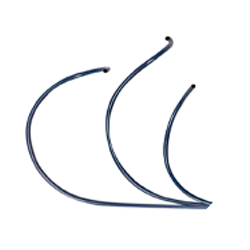Proven Success
Demonstrated 100% success rate in LBBAP procedures.1

Accommodating Solutions
Three unique distal curves and two lengths provide enhanced variability and reach to accommodate various patient anatomy needs.2

Features of CPS Locator™ 3D Catheters
- Designed to accept 6F stylet-driven leads, such as the UltiPace™ Pacing Lead, and provide better support with less risk of kinking.3
- The CPS Locator™ 3D is a single-use percutaneous catheter intended to introduce various types of catheters and pacing or defibrillator leads.
- Each CPS Locator™ 3D Catheter offers a unique distal curve to accommodate various anatomies.
- The catheter is equipped with a hemostatic valve, and the distal tip is radiopaque to facilitate imaging under fluoroscopy.
- The Slitter for CPS Locator™ 3D Catheter is designed to ensure alignment and protect the lead during catheter slitting.
- Accommodates a 6 F lead with a minimum length of 58 cm for the 42 cm catheters and 65 cm for the 45 cm catheters.
- The catheter has an inner diameter of 7 F, an outer diameter of 9 F, and the dilator is compatible with a 0.035” guidewire.
Ordering Information
| Model Number | Model Name | Overall Length (Cm) | Working Length (Cm) | Inner Diameter | Outer Diameter | Minimum Lead Length |
|---|---|---|---|---|---|---|
| DS2C100-42 | CPS Locator™ 3D, Small | 45 cm | 42 cm | 7 F (2.44 mm) | 9 F (3.00 mm) | 58 cm |
| DS2C200-42 | CPS Locator™ 3D, Medium | 45 cm | 42 cm | 7 F (2.44 mm) | 9 F (3.00 mm) | 58 cm |
| DS2C300-42 | CPS Locator™ 3D, Large | 45 cm | 42 cm | 7 F (2.44 mm) | 9 F (3.00 mm) | 58 cm |
| DS2C200-45 | CPS Locator™ 3D, Medium, Extra Long | 48 cm | 45 cm | 7 F (2.44 mm) | 9 F (3.00 mm) | 65 cm |
| DS2C300-45 | CPS Locator™ 3D, Large, Extra Long | 48 cm | 45 cm | 7 F (2.44 mm) | 9 F (3.00 mm) | 65 cm |
Stay Informed
Sign up to hear about our technology, education opportunities, and more.
Read the Latest Blog Article
Stay up to date with recent news, product highlights, and case studies.
References
- Nair, D., & Atwater, B. (2023). Abstracts - 2023 - journal of arrhythmia - wiley online library. Wiley Online Library. https://onlinelibrary.wiley.com/doi/10.1002/joa3.12902
- Abbott. Data on File, Competitive Summary. Item: MAT-2302264 v1.0
- Burri, H., Jastrzebski, M., Cano, O., Curila, K., Pooter, J. de, Huang, W., Israel, C., Joza, J., Romero, J., Vernooy, K., Vijayaraman, P., Whinnett, Z., & Zanon, F. (2023). Ehra clinical consensus statement on conduction system pacing implantation: Executive summary. endorsed by the Asia-Pacific Heart Rhythm Society (APHRS), Canadian heart rhythm society (CHRS) and Latin-American heart rhythm society (LAHRS). Europace : European pacing, arrhythmias, and cardiac electrophysiology : journal of the working groups on cardiac pacing, arrhythmias, and cardiac cellular electrophysiology of the European Society of Cardiology. https://pubmed.ncbi.nlm.nih.gov/37061850/
Important Safety Information:
Brief Summary: Prior to using these devices, please review the Instructions for Use for a complete listing of indications, contraindications, warnings, precautions, potential adverse events and directions for use.
Indications: The Delivery Catheter is indicated for the introduction of various types of catheters and pacing or defibrillator leads.
Contraindications: Obstructed or inadequate vasculature for venous access.
Complications: Possible complications include, but are not limited to, the following: exposure to x-ray radiation, adverse or allergic reaction to contrast agents, infection, hematoma, pneumothorax, embolization, vessel thrombosis, dissection, acute occlusion, clot formation, hemorrhage, vessel rupture, arrhythmia or heart block, hemodynamic changes, myocardial infarction, perforation of the heart, cardiac tamponade, stroke, and death.
MAT-2404048 v2.0


